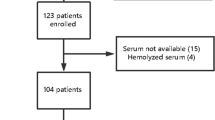Abstract
The pathogenesis of sepsis associated encephalopathy (SAE) is not yet clear: the blood–brain barrier (BBB) disruption has been indicated among the possible causative mechanisms. S100B, a calcium binding protein, originates in the central nervous system but it can be also produced by extra-cerebral sources; it is passively released from damaged glial cells and neurons; it has limited passage through the BBB. We aimed to demonstrate BBB damage as part of the pathogenesis of SAE by cerebral spinal fluid (CSF) and serum S100B measurements and by magnetic resonance imaging (MRI). This paper describes four septic patients in whom SAE was clinically evident, who underwent MRI and S100B measurement. We have not found any evidence of CSF-S100B increase. Serum S100B increase was found in three out of four patients. MRI did not identify images attributable to BBB disruption but vasogenic edema, probably caused by an alteration of autoregulation, was diagnosed. S100B does not increase in CSF of septic patients; S100B increase in serum may be due to extracerebral sources and does not prove any injury of BBB. MRI can exclude other cerebral pathologies causing brain dysfunction but is not specific of SAE. BBB damage may be numbered among the contributors of SAE, which aetiology is certainly multifactorial: an interplay between the toxic mediators involved in sepsis and the indirect effects of hyperthermia, hypossia and hypoperfusion.

Similar content being viewed by others
References
Sharshar T, Hopkinson NS, Orlikowski D, Annane D (2005) Science review: the brain in sepsis–culprit and victim. Crit Care 9:37–44. doi:10.1186/cc2951
Esen F, Erdem T, Aktan D, Orhan M, Kaya M, Eraksoy H, Cakar N, Telci L (2005) Effect of magnesium sulfate administration on blood–brain barrier in a rat model of intraperitoneal sepsis: a randomized controlled experimental study. Crit Care 9:R18–R23. doi:10.1186/cc3004
Baumann N, Pham-dinh D (2002) Astrocytes. In: Ramachandran VS (ed) Encyclopedia of the Human Brain. Academic Press, New York, pp 251–268
Donato R (2003) Intracellular and extracellular roles of S100 proteins. Microsc Res Tech 60:540–551. doi:10.1002/jemt.10296
Unden J, Christensson B, Bellner J, Alling C, Romner B (2004) Serum S100B levels in patients with cerebral and extracerebral infectious disease. Scand J Infect Dis 36:10–13. doi:10.1080/00365540310017294
Sharshar T, Carlier R, Bernard F, Guidoux C, Brouland JP, Nardi O, De la Grandmaison GL, Aboab J, Gray F, Menon D, Annane D (2007) Brain lesions in septic shock: a magnetic resonance imaging study. Intensive Care Med 33:798–806. doi:10.1007/s00134-007-0598-y
Piazza O, Russo E, Cotena S, Esposito G, Tufano R (2007) Elevated S100B levels do not correlate with the severity of encephalopathy during sepsis. Br J Anaesth 99:518–521. doi:10.1093/bja/aem201
Dellinger RP, Levy MM, Carlet JM, Bion J, Parker MM, Jaeschke R, Reinhart K, Angus DC, Brun-Buisson C, Beale R, Calandra T, Dhainaut JF, Gerlach H, Harvey M, Marini JJ, Marshall J, Ranieri M, Ramsay G, Sevransky J, Thompson BT, Townsend S, Vender JS, Zimmerman JL, Vincent JL (2008) Surviving sepsis campaign: international guidelines for management of severe sepsis and septic shock: 2008. Intensive Care Med 34(1):17–60. doi:10.1007/s00134-007-0934-2
Heizmann CW (2004) S100B protein in clinical diagnostics: assay specificity. Clin Chem 50:249–251. doi:10.1373/clinchem.2003.027367
Kleine TO, Benes L, Zofel P (2003) Studies of the brain specificity of S100B and neuron-specific enolase (NSE) in blood serum of acute care patients. Brain Res Bull 61:265–279. doi:10.1016/S0361-9230(03)00090-X
Reiber H (2001) Dynamics of brain-derived proteins in cerebrospinal fluid. Clin Chim Acta 310:173–186. doi:10.1016/S0009-8981(01)00573-3
Young GB, Bolton CF, Archibald YM, Austin TW, Wells GA (1992) The electroencephalogram in sepsis-associated encephalopathy. J Clin Neurophysiol 9:145–152. doi:10.1097/00004691-199201000-00016
Larsson A, Lipcsey M, Sjolin J, Hansson LO, Eriksson MB (2005) Slight increase of serum S-100B during porcine endotoxemic shock may indicate blood–brain barrier damage. Anesth Analg 101:1465–1469. doi:10.1213/01.ANE.0000180193.29655.6A
Kleindienst A, Hesse F, Bullock MR, Buchfelder M (2007) The neurotrophic protein S100B: value as a marker of brain damage and possible therapeutic implications. Prog Brain Res 161:317–325. doi:10.1016/S0079-6123(06)61022-4
Tsao N, Hsu HP, Wu CM, Liu CC, Lei HY (2001) Tumour necrosis factor-alpha causes an increase in blood–brain barrier permeability during sepsis. J Med Microbiol 50:812–821
Bartynski WS, Boardman JF, Zeigler ZR, Shadduck RK, Lister J (2006) Posterior reversible encephalopathy syndrome in infection, sepsis, and shock. AJNR Am J Neuroradiol 27:2179–2190
Servillo G, Bifulco F, De Robertis E, Piazza O, Striano P, Tortora F, Striano S, Tufano R (2007) Posterior reversible encephalopathy syndrome in intensive care medicine. Intensive Care Med 33:230–236. doi:10.1007/s00134-006-0459-0
Author information
Authors and Affiliations
Corresponding author
Rights and permissions
About this article
Cite this article
Piazza, O., Cotena, S., De Robertis, E. et al. Sepsis Associated Encephalopathy Studied by MRI and Cerebral Spinal Fluid S100B Measurement. Neurochem Res 34, 1289–1292 (2009). https://doi.org/10.1007/s11064-008-9907-2
Accepted:
Published:
Issue Date:
DOI: https://doi.org/10.1007/s11064-008-9907-2




